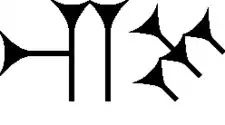Zi (cuneiform)
The cuneiform zi sign is a common multi-use sign of the Epic of Gilgamesh, the 1350 BC Amarna letters, and other cuneiform texts. It also has a sumerogrammic usage for ZI in the Epic of Gilgamesh. The structure of the cuneiform sign is like its twin, Gi (cuneiform), ![]() .
.

Cuneiform for ze, zi, and ZI; digitized form.
.jpg.webp)
Old Assyrian cuneiform for ze, zi, and ZI.
_of_Egypt%252C_matching_fragment_in_British_Museum_-_Oriental_Institute_Museum%252C_University_of_Chicago_-_DSC07018.JPG.webp)
EA 26, fragment (Obverse).
(high-resolution expandable photo)
(Last flat-surface 5-lines on fragment (Para IV), lines 30-34.
(An Amarna letter that uses zi.)
(high-resolution expandable photo)
(Last flat-surface 5-lines on fragment (Para IV), lines 30-34.
(An Amarna letter that uses zi.)
| Wikimedia Commons has media related to Zi (cuneiform). |
The "zi" sign has the syllabic usage for ze and zi, and a Sumerogram usage for ZI. Alphabetically "zi" can be used for z ("z" can be interchanged with any "s"); and "zi"/"ze" can be used for i, or e. In Akkadian, all 4 vowels, a, e, i, u are interchangeable with each other.
Epic of Gilgamesh usage
The zi sign usage in the Epic of Gilgamesh is as follows: ze-(6 times); gi-(46), ZI-(32 times).[1]
References
- Parpola, 197l. The Standard Babylonian Epic of Gilgamesh, Sign List, pp. 155-165, no. 084, p. 156, "zi".
- Moran, William L. 1987, 1992. The Amarna Letters. Johns Hopkins University Press, 1987, 1992. 393 pages.(softcover, ISBN 0-8018-6715-0)
- Parpola, 197l. The Standard Babylonian Epic of Gilgamesh, Parpola, Simo, Neo-Assyrian Text Corpus Project, c 1997, Tablet I thru Tablet XII, Index of Names, Sign List, and Glossary-(pp. 119–145), 165 pages.
This article is issued from Wikipedia. The text is licensed under Creative Commons - Attribution - Sharealike. Additional terms may apply for the media files.